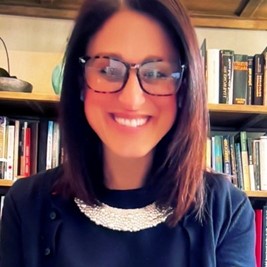
Jennifer E. Phillips-Cremins, Ph.D. is an Associate Professor and Deans’ Faculty Fellow in Engineering and Medicine at the University of Pennsylvania with primary appointments in the Departments of Genetics and Bioengineering. Dr. Cremins obtained her Ph.D. in Biomedical Engineering from the Georgia Institute of Technology in the laboratory of Andres Garcia. She conducted a multi-disciplinary postdoc in the laboratories of Job Dekker and Victor Corces. Dr. Cremins now runs the Laboratory of Chromatin and Spatial Neurobiology at UPenn. Her primary research interests lie in understanding the long-range chromatin architecture mechanisms that govern neural specification and synaptic plasticity in healthy neurons and how chromatin is dysregulated in neurodevelopmental and neurodegenerative diseases. She has been selected as a 2014 New York Stem Cell Foundation Robertson Investigator, a 2015 Albert P. Sloan Foundation Fellow, a 2016 and 2018 Kavli Frontiers of Science Fellow, 2015 NIH Director’s New Innovator Awardee, 2020 NSF CAREER Awardee, a 2020 CZI Neurodegenerative Disease Pairs Awardee, the 2022 ISSCR Susan B. Lim Outstanding New Investigator Award, and as a recipient of the 2021 NIH Pioneer Award.
Faculty Honors and Awards
2024 NIH WALs lecturer
2022 ISSCR Susan B. Lim Outstanding New Investigator Award
NIH Pioneer Award (2021)
UPenn Deans’ Faculty Fellow in Engineering and Medicine (2020 – present)
Chan-Zuckerberg Initiative Collaborative Neurodegenerative Disease Pairs Award (2020)
NSF CAREER Award (2020-2025)
Nature Magazine’s Technologies to watch in 2020:
https://www.nature.com/articles/d41586-020-00114-4
NSF Emerging Frontiers in Research Innovation – Chromatin & Epigenetic Engineering awardee 2019
Nature Methods featured author profile:
https://www.nature.com/articles/nmeth.4584 (2018)
Kavli Frontiers of Science Fellow (2018)
Kavli Frontiers of Science Japanese-American-German Frontiers of Science Symposium invitee (2017)
Kavli Frontiers of Science Fellow (2016)
Cell Stem Cell featured author profile:
https://doi.org/10.1016/j.stem.2016.11.016
NIH Director’s DP2 New Innovator Award (2015-2020)
Alfred P. Sloan Research Fellow (2015-2017)
New York Stem Cell Foundation – Robertson Investigator (2015-2020)
Postdoctoral Awards
Winner – Keystone Future of Science Award: Keystone Symposia on
Epigenomics and Chromatin Dynamics (2012)
Semi-Finalist – Burroughs Wellcome Fund Career Award at the Scientific
Interface (2011)
Winner – NIH Ruth S. Kirschstein F32 National Research Service Award
(June 2009-2012)
Doctoral Awards
Winner – Georgia Institute of Technology Presidential Fellowship
(2003-2007)
Winner – National Science Foundation Graduate Fellowship (2003-2006)
Winner – Travel Award: 1st Annual NIH Graduate Research Festival in
Washington, DC (2006)
Winner – Travel award: 2nd Marie Curie Cutting-Edge Conference in Alvor,
Algarve, Portugal (2006)
Winner – Scholarship: Human embryonic stem cells (HEST) workshop at UGA
(2005)
Winner – Tissue Engineering Society Travel Award: 7th Annual Meeting
Lausanne, Switzerland
Winner – Best Poster Competition: 12th Annual Bud Suddath Bioscience
Symposium (2004)
Undergraduate Awards
Promoted to Senior Scientist/Engineer – Procter & Gamble Skin Care R&D
(2001)
Society of Women Engineers (1995-1999)
Tau Beta Pi National Engineering Honors Society (1996-1999)
Vice President – Omega Chi Epsilon Chemical Engineering Honor’s Society
(1999)
Graduated with Highest Distinction from Clarkson University (1999)
Clarkson University Presidential Scholar (1995-1999)
Captain – Clarkson University Basketball Team (1997-1998)
Just like the digital codes of replicating life held within DNA, the brain’s fundamental secret will be laid open one day. But even when it has, the wonder will remain, that mere wet stuff can make this bright inward cinema of thought, of sight and sound and touch bound into a vivid illusion of an instantaneous present, with a self, another brightly wrought illusion, hovering like a ghost at its centre. Could it ever be explained, how matter became conscious? –Ian McEwan, Saturday (Jonathan Cape, 2005), pp. 254-255
